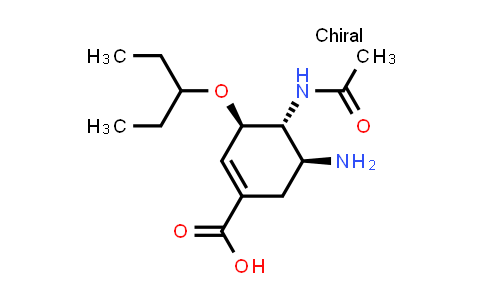| Chemical Name |
Oseltamivir acid |
| CAS Number |
187227-45-8 |
| MDL Number |
MFCD00953940 |
| Molecular Formula |
C14H24N2O4 |
| Molecular Weight |
284.35 |
| Synonyms |
GS 4071;Ro 64-0802;Oseltamivir carboxylate |
Introduction of 187227-45-8 :
Oseltamivir acid (GS 4071), the active metabolite of Oseltamivir phosphate, is an orally bioavailable, potent and selective inhibitor of influenza virus neuraminidase (IC50=2 nM) with activity against both influenza A and B viruses[1][2]. IC50 & Target: IC50: 2 nM (influenza virus neuraminidase) In Vitro: Oseltamivir acid inhibits virus replication in vitro and in vivo. Influenza B and A/H1N1 viruses appeare to be sensitive to Oseltamivir (mean B IC50 value: 13 nM; mean H1N1 IC50 value: 1.34 nM), while A/H1N2 and A/H3N2 viruses are more sensitive to Oseltamivir (mean H3N2 IC50 value: 0.67 nM; mean H1N2 IC50 value: 0.9 nM)[3].
In neuraminidases inhibition assays with influenza A viruses, the IC50 of RWJ-270201 (approximately 0.34 nM) is comparable to that of Oseltamivir carboxylate (0.45 nM) For influenza B virus isolates, the IC50 of RWJ-270201 (1.36 nM) is comparable to that of Zanamivir (2.7 nM) and less than that of Oseltamivir carboxylate (8.5 nM)[4]. In Vivo: Oseltamivir (0.1, 1, or 10 mg/kg/day, twice daily by oral gavage) produces a dose-dependent antiviral effect against Vietnam/1203/04 (VN1203/04) virus. The 5-day regimen at 10 mg/kg/day protects 50% of mice; deaths in this treatment group are delayed and indicated the replication of residual virus after the completion of treatment. Eight-day regimens improved Oseltamivir efficacy, and dosages of 1 and 10 mg/kg/day significantly reduced virus titers in organs and provided 60% and 80% survival rates, respectively[5].
In the pharmacokinetic study, after the oral administration of 1,000 mg/kg Oseltamivir, peak plasma concentrations are reached at 2 h postdose for Oseltamivir and 8 h for Oseltamivir carboxylate (OC). Rats are exposed to Oseltamivir over the whole sampling interval and had a ~2.7-fold-higher rate of exposure to OC than Oseltamivir. In CSF, peak concentrations are reached at 2 h postdose for Oseltamivir and 6 h for OC. CSF/plasma exposure ratios (AUC0-8 h) are ~0.07 for Oseltamivir and 0.007 for OC. In perfused brain samples, peak concentrations are reached at 8 h postdose for Oseltamivir and 6 h for OC. Brain/plasma exposure ratios (AUC0-8 h) of ~0.12 for Oseltamivir and 0.01 for OC are recorded. Corresponding CSF/brain exposure ratios ranged between ~0.55 and 0.64 for both analytes. A further group of animals that received a single oral administration of Oseltamivir at a lower dose produced similar results[6].
| Purity |
NLT 98% |
| Storage |
at 20ºC 2 years |
*The above information is for reference only.
